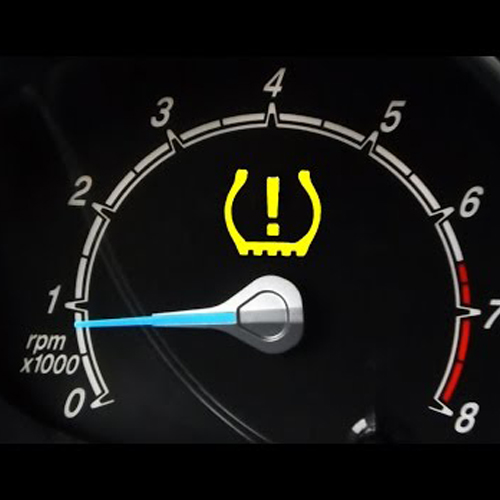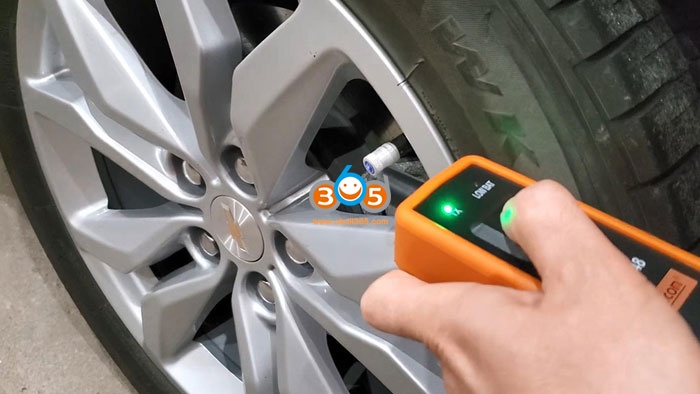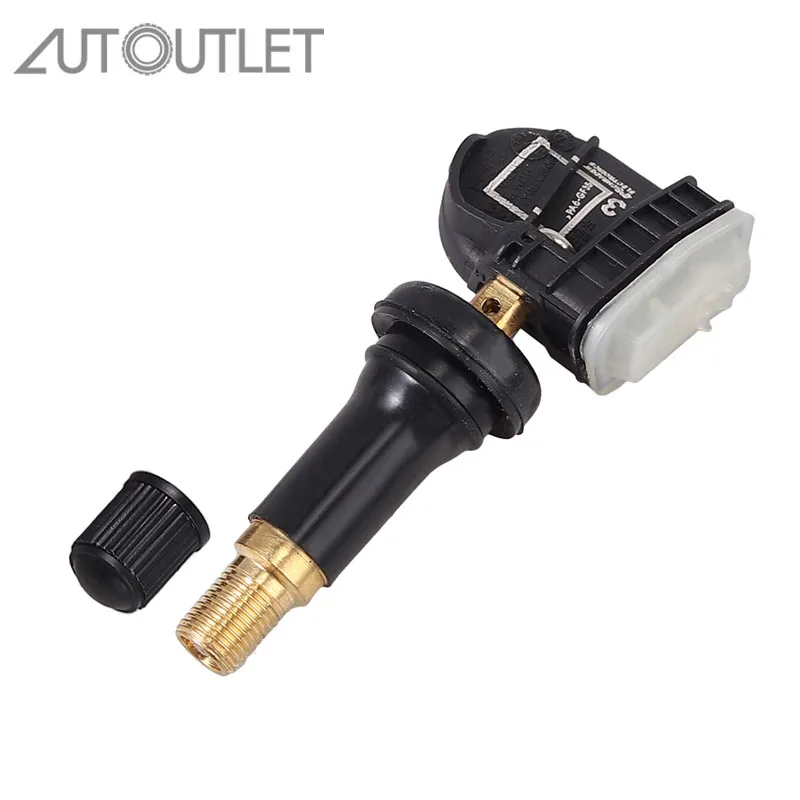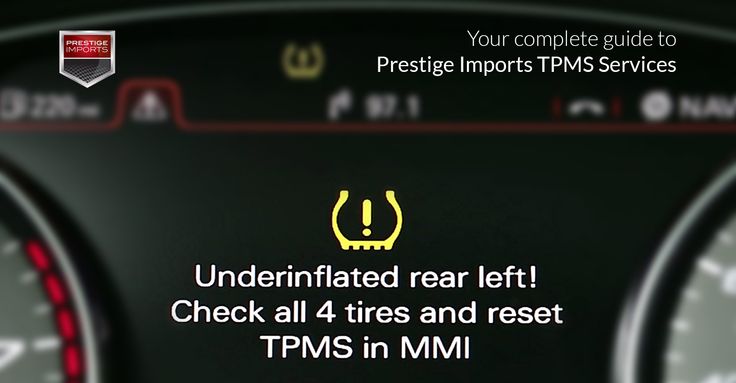by Jennifer S.
If the Tire Pressure Management System in the Chevy Silverado is not working properly, you may have to reset the TPMS system. Follow these steps to re-initialize it.
The light indicator is a notification to warn you of significantly low air pressure or high-pressure loss in your tires and is NOT to be ignored, as low pressure affects the vehicles overall performance such as:
First, Check the Recommended Air Levels Needed:
Keep in mind, after tires are inflated, the outdoor temperature affects how fast the air in the tires will adjust to the proper temperature, this could take minutes, a day, 2 or 3, simply be patient and give the tires time to adjust. In addition, if the tire pressure warning light stays illuminated past a week, you will need to have your vehicle serviced as there could possibly be a sensor issue or a tire puncture.
NOTE: If you are unable to Reset the Tire Pressure Warning Light in the Chevy Silverado on the first try, REPEAT the steps. If you are still unsuccessful, contact the dealership for assistance or consult your vehicle user’s manual.
Contents

Switch the key from ON to OFF then back ON. The warning light should be gone.
 Be patient as this could take up to 30 seconds for each tire.
Be patient as this could take up to 30 seconds for each tire. 
Posted on by TPMS Direct
TPMS SYSTEM BACKGROUND – how TPMS is integrated into the vehicle’s computer:
The tire pressure monitor (TPMS) system uses the passenger door module (PDM), the body control module (BCM), the exterior lamp switch, the 4 radio frequency transmitting pressure sensors in the tire valves, and the serial data circuit to perform the sensor learn mode functions.
To read correctly, the sensor learn procedure must be performed any time the PDM is replaced, a tire sensor is replaced, or after the vehicles tires have been rotated. Once the learn mode has been enabled, each of the sensors’ unique identification code can be programmed (“learned”) into the PDM’s memory. When a sensor’s ID code has been learned, the PDM sends a serial data message to the BCM to sound a horn chirp. This verifies the sensor has transmitted it’s ID code and the PDM has received it. As soon as the first sensor ID code is learned, all other IDs are erased from the PDM’s memory.
SENSOR FUNCTIONS
Each sensor takes a pressure measurement sample once every 20 seconds while in stationary mode. If the tire pressure increases or decreases by more than 1.6 PSI from the last pressure measurement, another measurement will occur immediately to verify the change in pressure. If a pressure change has indeed occurred, the sensor sends a re-measure signal to the PDM. When the PDM receives a re-measure signal while in sensor learn mode, it will assign that sensor ID to that location on the vehicle.
When the PDM receives a re-measure signal while in sensor learn mode, it will assign that sensor ID to that location on the vehicle.
SENSOR LOCATION
The PDM must learn each sensor’s ID code in the proper sequence in order to determine sensor location.
LEARN MODE CANCELLATION
The TPM system will cancel the learn mode if more then 2 minutes have passed and no sensors have been learned, or if the system has been in learn mode for more than 5 minutes. If the learn mode is canceled before any sensor has been learned, the PDM will remember all current sensor IDs and their locations.
CAUTION: Before proceeding with the steps below, ensure that no other sensor learn procedure is being performed simultaneously, or that tire pressures are not being adjusted on a TPM equipped vehicle within close proximity.
STEP BY STEP:
 IMPORTANT: If the learn mode cannot be enabled, ensure the TPM system is enabled in the PDM.
IMPORTANT: If the learn mode cannot be enabled, ensure the TPM system is enabled in the PDM.
Right front
Right rear
Left rear
Like Loading...
Bookmark the permalink. You are an enthusiastic new car owner, the joy of tactile devices, integrated technologies should bring you the ease and comfort of using your Chevrolet Silverado, however, which is to say that the technology is talking about electronic, and, like all of us, to Unfortunately, we often know that there are problems that need to be solved. Today we will look at the tire pressure sensor and exactly how to reset the tire pressure sensor on a Chevrolet Silverado so that you no longer have this indicator on the dashboard. To do this, we will divide our article into two parts: first we will talk about the classic case when the tire pressure indicator appears and the subsequent operation, and then that the tire pressure indicator remains on despite the tires being inflated. So, how to reset this tire sensor on a Chevrolet Silverado.
To do this, we will divide our article into two parts: first we will talk about the classic case when the tire pressure indicator appears and the subsequent operation, and then that the tire pressure indicator remains on despite the tires being inflated. So, how to reset this tire sensor on a Chevrolet Silverado.
First, we will look at the general approach to reset a tire sensor on a Chevrolet Silverado which if it lights up, here are the basic basic steps:

 Generally speaking, you need to look at the parameters of the car, then you should find the option to detect inflation or "detect deflation" when in this tab you have to hold down the select button or the reset button depending on the year of your Chevrolet. Silverado until a message appears from the car console confirming that the reset has been taken into account (this usually takes a few seconds). You can now turn off the ignition and restart your Chevrolet Silverado to see if the tire pressure light has gone out.
Generally speaking, you need to look at the parameters of the car, then you should find the option to detect inflation or "detect deflation" when in this tab you have to hold down the select button or the reset button depending on the year of your Chevrolet. Silverado until a message appears from the car console confirming that the reset has been taken into account (this usually takes a few seconds). You can now turn off the ignition and restart your Chevrolet Silverado to see if the tire pressure light has gone out.  However, this procedure is not recommended as it may result in improper handling and malfunction of your Chevrolet Silverado. Now you have all the keys to know how to reset the tire pressure sensor on Chevrolet Silverado.
However, this procedure is not recommended as it may result in improper handling and malfunction of your Chevrolet Silverado. Now you have all the keys to know how to reset the tire pressure sensor on Chevrolet Silverado. For more Chevrolet Silverado tips, take a look at the Chevrolet Silverado category.
Save article:
The article says:
When the tires are optimally inflated, the low tire pressure indicator (TPMS) does not light up on the vehicle's dashboard. However, in some cases, it lights up even if the pressure is normal. This can't help but be annoying, especially when the tires are inflated normally. In our article today, we will figure out how to reset a tire pressure error.
American and European scientists conducted a study, during which it was found that most drivers do not check whether the wheels are properly inflated before getting behind the wheel of a car. Only 40% of car owners perform such a check - and even then only once every 12 months. This is the reason for a large number of accidents.
The TPMS (Tyre pressure monitoring system) system is designed to monitor tire pressure, as well as warn of a malfunction. If the tires are under-inflated or over-inflated, an error will be displayed on the remote control or an audible signal will appear.
What is dangerous too high or, conversely, low pressure? The risk of an accident increases, the car begins to consume more fuel, in addition, the rubber wears out faster.
Photo: Shutterstock
The above devices operate on the same principle. Let's figure out how information about what tire pressure gets to the control panel.
Consider how pressure is calculated by measuring instruments. Typically, the sensor performs a comparison of the angular rotation of the wheel. Knowing the value of this parameter, you can calculate the distance that the wheel will travel in one rotation.
Knowing the value of this parameter, you can calculate the distance that the wheel will travel in one rotation.
Obviously, if the tires are under-inflated or over-inflated, then the outer diameter of the wheel will be different. Visually, a person cannot determine this change. But the sensor notices even such changes. The system fixes non-compliance with the required parameters.
The sensor will still respond, despite the fact that the wheel circumference has changed quite a bit. In this situation, it is necessary to find out what mechanical reason led to this. Only in this way can you eliminate the misinterpretation of the signals transmitted by the system. This can happen because:

Also, the TPMS system gives an error when you install new wheels or rearrange them.
When, after these steps, a tire pressure error appeared, indicating unbalance, you should reset the settings, and then set the basic parameters. In this case, the control signal may remain even if the basic settings have been selected.
Why such problems may occur:
 At the same time, as soon as you drive out onto an asphalt surface or start driving calmly, the error disappears.
At the same time, as soon as you drive out onto an asphalt surface or start driving calmly, the error disappears.
See also
"Velcro or spikes: which rubber is better for the Russian winter"
Read more
How to reset tire pressure error? To begin with, imagine that the TPMS system is working properly and the blinking light indicates a problem with the undercarriage of the machine. The first thing you should do is slowly release the gas. You can not brake sharply, turn the steering wheel. After the car has stopped, inspect the tires to make sure the rubber is not punctured or broken. Then you can check if the tire pressure is normal.
Pay attention! The TPMS will not always show a tire pressure error. For example, if the tires are slowly deflating, the system will not inform you about the problem. In the same way, she will not notice the error if the tire pressure starts to drop rapidly. This usually happens when a tire ruptures. This feature of the TPMS system is explained by the specifics of identifying and counting nonconformities.
In the same way, she will not notice the error if the tire pressure starts to drop rapidly. This usually happens when a tire ruptures. This feature of the TPMS system is explained by the specifics of identifying and counting nonconformities.
However, in some cases, it happens that the TPMS system indicator is on, but the tires are in perfect condition. How to reset tire pressure error? We understand.
The complex TPMS system in some cases starts to work incorrectly. Usually, car owners observe the following picture: a tire pressure error is displayed on the display (the tire is underinflated), but in reality everything is fine with the wheel. You have to reset the tire pressure error. Otherwise, the TPMS system starts to work incorrectly.
Photo: Shutterstock
You also have to reset the tire pressure error when there is radio interference from high voltage power lines. Or when sources of radio signals are located in the immediate vicinity. But as soon as you move away from them, the pressure error disappears and the system begins to function properly.
But as soon as you move away from them, the pressure error disappears and the system begins to function properly.
The reason for the malfunction may lie in the sensor, which is "failed". This damage cannot be easily repaired. How to reset a tire pressure error if the sensor flashes, while you hear a beep, lose your vigilance and find it difficult to drive a car? There are 4 ways to fix this problem.
To reset the error, pick up a speed of 80 km / h and continue driving for another 15 kilometers.
This method is the easiest to implement. If your car has this feature, then turn on the cruise control so that the speed does not change. Depending on the model of your car, you will be able to reset the tire pressure error at a speed that exceeds the specified one. After you cover a distance of 15-20 kilometers, maintaining the same speed of 80 km / h, make a stop. Turn off the motor. When you start it again, the tire pressure error will disappear.
Popular articles
From top to bottom, obliquely: how to degrease a car body before painting
12/15/2022
8
Chic, shine, beauty: how to remove scratches on a car with your own hands
9.12.2022
89
Without damage: how to reduce the fuel consumption of your car
11/29/2022
130
How much do they pay for advertising on a car
11/25/2022
281
Best car tool kit
11/18/2022
230
Press the tire pressure monitoring system (TPMS) reset button on your car and you will be able to reset the error.
It does not matter what type of low pressure warning system is used. In any case, there will be a sensor on each wheel of your car. Sometimes it may be necessary to reboot the touch system of the car. Read the owner's manual for the vehicle. It contains information on how to reset a tire pressure error. Most often, the instructions indicate which button to press to reset.
The ignition key must be in the lock. No need to start the car, just turn it to the “on” (“ON”) position. Then press and hold the reset button, which may be under the steering wheel. We are waiting for the low pressure indicator to blink 3 times. After that, you can release the button. We start the car, it should work for 20 minutes. After this time, the computer will calibrate the sensors on the wheels. Now you can turn off the car.
See also
""
Read more
Lower and then re-inflate the wheels.
Failed to reset tire pressure error using the previous method? Then we inflate all tires to 0.2 bar, this is the pressure that should be according to the recommendations of car manufacturers. Did the error go away? Then we lower the pressure in the tires completely.
Now we pump up the wheels again. The pressure in them should be the same as indicated on the driver's door pillar or in the car's operating instructions. When there are sensors on the wheels, you need to remember about the spare tire. Now you need to drive about 3-5 kilometers, adhering to a speed of 25 km per hour. So you can reset the tire pressure error.
Remove the battery terminals and then connect it to reset the error.
Each car has a computer that receives data from all kinds of vehicle sensors, including TPMS system sensors. However, any electronics can fail. To reset the error, you will have to reboot the system, for which you need to turn off the power.
Photo: Shutterstock
To do this, open the hood. The battery is located under the hood. Disconnect the negative terminal from it. To perform this operation, use a wrench. Then sit in the driver's seat, turn the key to the "ON" position, but do not start the car. Now you need to press the signal for 3 seconds. This will use up the energy that remains in the electrical system of the machine. Then reconnect the battery. This way you can reset the error.
Sensors keep track of tire pressure. However, you need to be sure that they function properly. Of course, you do not need to constantly walk around with a special measuring device and find out the status of the sensors. It just needs to be calibrated from time to time.
It is performed quite simply. The most important thing to remember is that, depending on the make and model of your car, for each wheel there are pressure parameters strictly defined by the manufacturer for winter and summer. These values should be given to the sensors. How the installation and configuration will be performed depends on the controller used.
These values should be given to the sensors. How the installation and configuration will be performed depends on the controller used.
 Experts do not recommend using the internal controller yourself. However, additional settings are not required if the data is read using the screen that is directly on the control system.
Experts do not recommend using the internal controller yourself. However, additional settings are not required if the data is read using the screen that is directly on the control system. For current promotions on the Halva card, which will help you profitably purchase household appliances, you can follow here.
To prevent a tire pressure error from appearing, it is important to calibrate (adjust the TPMS system) every time a change is made. For example, when you installed a new set of wheels, repaired tires, did balancing, and the like. Using TPMS controllers is quite simple. The main thing is to read the instructions for use of the device. And make sure that the tire pressure is the one recommended by the car manufacturer.
See also
"What tires can be put on rims 14, 15 and 16: advice from professionals"
Read more
Every car owner gets annoyed if the tire pressure error icon lights up on the dashboard.